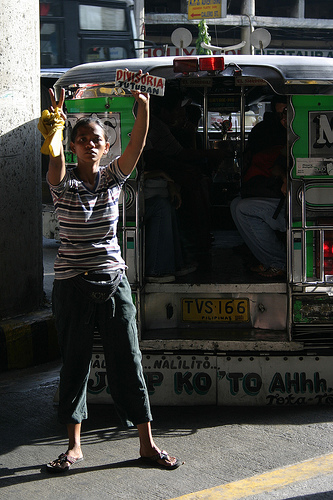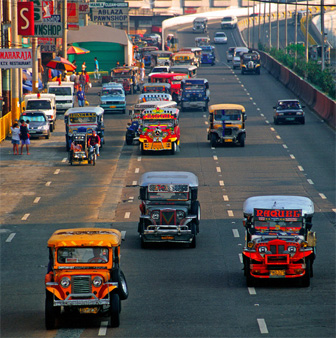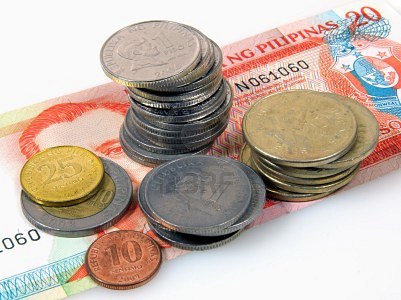My First Jeepney Ride: 5 tips to get you started. Bayad Po!
If you knew how much time I have spent in the Philippines over the years, you would say I deserve to be force fed sour balut for not having jumped on a jeepney until now. Here are a few pointers for your first ride-along.
Maraming Salamat po to The Philippines Facebook page for sending some people over to this post!
If you have been to the Philippines, you are familiar with the jeepney, the half-bus-half-jeep vehicles that are EVERYWHERE in the cities. At less than 9pesos (20 cents) per ride, it’s the cheapest form of social travel you’ll find in the Philippines.
Taking a jeepney your first time is a bit daunting. The routes are almost impossible to decipher for non locals and the payment system is completely different than anything in the west. Add to that stories you hear from foreigners about how people get robbed or pick-pocketed on jeepneys, and you just end up taking taxis everywhere. (Not that they are any safer, but I digress).
On my last trip, my good friend Denice, the editor in chief of a local travel magazine, felt it was time I tried one and she showed me the ropes. I loved it! It was a small experience, and, being in downtown Makati, relatively tame and controlled, but it still reminded me that the point of travel is to go outside of your comfort zone. Lesson learned.
Jeepney Riding 101: Five Pointers to get you on your way!
1. Ask before you ride!
This is probably the most important advice I can give. Most Westerners are used to a very antisocial travel system. Routes and buses are clearly marked, so you can read where you need to go. When necessary, you can ask the driver. Not in the Philippines.
In the Philippines, other than terminal stops, jeepneys will stop anywhere and any time a passenger wishes to get on or off (this applies to most conventional buses as well). And if you do find an official stop, you won’t find any printed information on routes. Yes, the jeepneys are marked with destination names, but with all the decoration and bling they have, plus the fact that Filipino place names have about a dozen vowels each, it can be tough to read and figure things out in the 2.3 seconds you have as the jeepney approaches.
So your first step in taking a jeepney is to get social. On any major road you will see people clustering waiting for jeepneys, especially in office areas. Just ask people for help. Tell them where you want to go and somebody will make sure you get on the right jeepney.
2. Make sure somebody knows where you need to get off
It helps to let somebody know where you are going. Either try to sit near the driver, or employ a passenger’s help to tell you where to get off. Even for a major stop like Ayala, you might be looking to get off at the Greenbelt Mall, but you will actually need to get off at the Ayala stop on EDSA. If the driver or a friendly passenger knows this, they will make sure you hit that stop, even if you miss it yourself.
3. Carry small change
If you get on a jeepney — or even a taxi — with a 1000Peso note (about $20), you will not be the most popular person on the jeepney — except maybe to potential scammers or muggers. The people who normally ride jeepneys are the working class. For many of them, the driver included, $20 may be be the equivalent of a few days wages. Indeed, the waiter at my favorite live-music resto in Manila makes, after a 12 hour shift, 150 pesos. That’s about $3…a day! So when you get on the jeepney, don’t hand the driver anything larger than a 20 peso note. A 10 peso coin is ideal.
4. Bayad Po! and Bayad Daw!
Now the fun part. Payment! Most rides of 4 to 5 Km are less than 9 Pesos. You will need to pay more for longer rides. If you are not at the front of the jeepney, pass your money forward to the driver by saying (don’t yell) “Bayad Po!” (My payment). Somebody will take your money and pass it along to the driver. At this time, if you know where you want to get off the jeepney, then call that out also. Not only will the driver know where to stop, but the cost of your ride might be more if you are going a long distance.
If you are paying for more than one person, then just as the money is arriving at the driver, call out loud enough for the driver to hear, “Dalawa!” for two people, or “Tatlo” for three if you are a popular type with more friends than me. The driver will pass the change back down the chain gang.
And this is one good reason to sit near the back of the jeepney. It’s less work. When you sit right at the front, as I did, you are now the official money changer. And even on a short trip, that can mean a LOT of people sending money up to you to give to the driver. If you find yourself in this position of authority, then you should also know the word, “Bayad Daw” (Pronounced Buy-add Dao). That means that the money is not yours, but that you are representin’ somebody who just got on.
5. Learn Morse Code
When you get to your destination, just clink a coin a few times on the hand rail running along the inside roof of the jeepney (again, this often applies to regular buses if you need to get off at an unusual destination). You might not need to do this if you have told the driver where to stop, but it will impress the locals at how well you fit into the jeepney culture. Or you can be even cooler by calling out “Para”….Stop!
And speaking of jeepneys…
One of the best documentaries I have ever seen is this BBC production that sent a London bus driver over to learn how to drive a jeepney. In fact, it is less about the jeepney than about the life of a hard-working Filipino driver struggling to make a life for his family.




I don’t use taxis or tuk tuks that much when travelling, but always apply these rules. I ask for the price before I get in as drivers are likely to change their prices later on. Good you pointed out the money issue. It’s very important to carry some change. They are so many problems with changing money. Great tips!
LikeLike
Thanks for the comment! Yeah, I always ask for the price up front. If you guys haven’t put the Philippines on your itinerary, do so. Insanely gorgeous beaches there!
LikeLike
When I originally commented I clicked the “Notify me when new comments are added” checkbox and now each time a comment is added I get three emails with the same comment.
Is there any way you can remove me from that service?
Bless you!
LikeLike
I’ll see if I can delete the original comment you left. Cheers.
LikeLike
Actually, I can’t find your original comment. Was it on this thread about Jeepneys?
LikeLike
You are getting a lot of traffic today because a Facebook profile called The Philippines shared your blog on its page.
LikeLike
Thanks so much for letting me know. I appreciate it. I’ll put a back-link to their page to say thanks. Thanks again for the intel!
LikeLike
Pingback: Go, Go… Brake! Brake! | Girl, Uninspired
Pingback: Arrivée à Manille, la capitale des Philippines | colombefreiontheroad
Hi there, I’m native here in Philippines, and still have a hard time riding on a jeep. I’m always acting awkward. T.T
LikeLike
They sure are fun, though! 🙂
LikeLike
Nice article.
LikeLike
Thanks, Jack!
LikeLike
Pingback: Manila to Boracay - Travelin' with JC
Pingback: What to say when riding a jeepney in Cebu City - Peps&Coks Travelog
I think commuting by jeepney will be fun, but crazy. Your photos remind me of the horrible images with long bus in India. I will never come back there. One thing I suspect is whether travelling by Jeepney is safe or not. Is there metro system in Manila? Thanks so much for your sharing!
LikeLike
Thanks for stopping by. The problem with the jeepneys is that a LOT of pickpockets and theft happens. So you really need to watch your stuff. And yes, there are a couple of over-ground public transit train lines.
LikeLike
Pingback: What to say when riding a jeepney in Cebu City